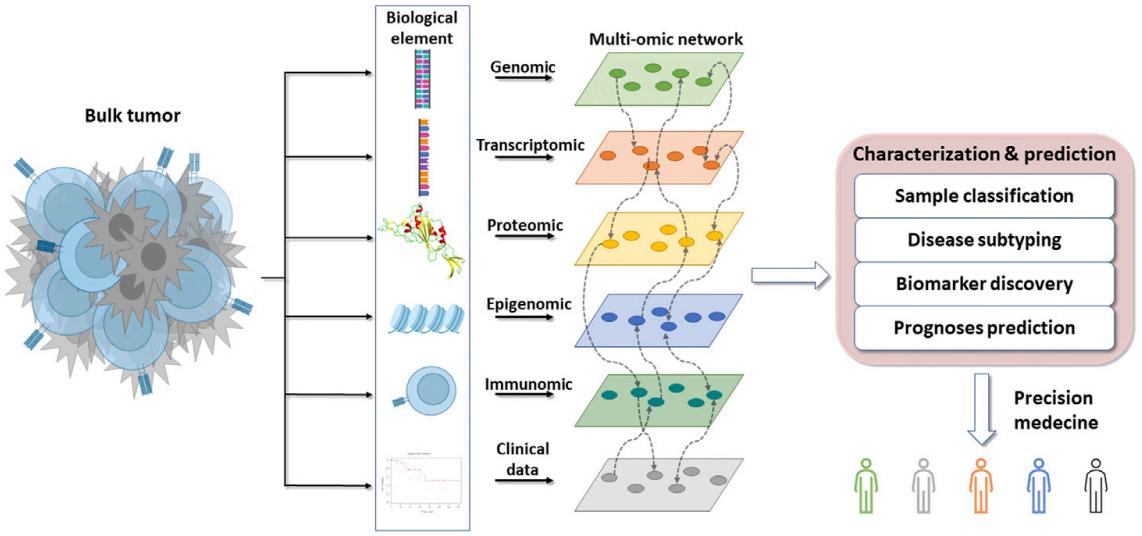Immunomics in Cancer
Immunomics in cancer refers to the comprehensive study of cancer and the tumor immune microenvironment (TIME) using immunogenomics, proteomics, informatics and other histological data reflecting the immune status of the tumor. The immunomics global approaches reveal incredible complexity, unanticipated molecular diversity within the same tumor type, and spatial and temporal heterogeneity of tumors. The integration of multiple biological levels of omics research has brought oncology into a new paradigm.
 Fig.1 Overflow of
the omics integration for cancer research, diagnosis, and treatment. (Raufaste-Cazavieille, et al., 2022)
Fig.1 Overflow of
the omics integration for cancer research, diagnosis, and treatment. (Raufaste-Cazavieille, et al., 2022)

Sample Classification
Tumor heterogeneity remains a barrier to understanding tumor biology. For the same tumor type, the clinical evolution varies considerably in different patient groups, especially in terms of tumor cell progression or mutations. These differences are an obstacle to the development of efficient therapies. Cancers are relatively easy to classify as the classification is now based on the tissue type and site of origin of the tumor. With the introduction of genomics and molecular characterization, omics data can be used to individualize tumor types. The basic principles and steps of tumor classification mainly include discrete cluster analysis, selection of the most relevant (clustered) genes, and a logical formula for characterizing the sample.

Disease Subtyping
Subtyping of cancers is complex and remains one of the major challenges in cancer research. The identification of subtypes can provide an understanding of the underlying molecular mechanisms, which can help design precise therapeutic strategies for efficient cancer management. Molecular classification facilitates the elucidation of the heterogeneity of tumors. Different cancer subtypes can be identified based on different levels of biological elements, such as genomics, alterations, gene and protein expression profiles and cell composition. The main challenge is to be able to accurately analyze large amounts of data and to identify and isolate predictive patterns. Multi-omics provides a powerful approach to handle, process, and characterize the large amount of data required for cancer subtyping.

Biomarker Discovery
Providing clinical data as additional features to multi-layered integrative models allows for correlations between molecular subtypes and clinical outcomes. The discovery of biomarkers associated with prognosis and treatment sensitivity/resistance is key to risk group classification and treatment decisions. The identification of specific therapeutic biomarkers also offers the opportunity to provide therapeutic approaches that target specific tumor biomarkers, opening the way for precision medicine.

Prognoses Prediction
Many methods based on genomic, transcriptomic, and proteomic data have been successfully applied to improve tumor prognosis prediction. These methods have improved the accuracy of classification of ill-defined groups of soft tissue sarcomas and also enable the annotation of samples into molecular subgroups with potential therapeutic sensitivity. Immunomics has been applied to predict prognosis and improve patient survival by guiding treatment decisions would.

Host-tumor Interplay Deciphering
The study of immunological cancer responses is used to unravel host-tumor interactions and to understand how tumor cells deceive their hosts and escape their defenses to favor cancer immune evasion. An understanding of the mechanisms of immune escape opens the way to immune-mediated therapeutic opportunities. Furthermore, combining multiple biological elements of the tumor and host environment is an extremely effective way to dissect TIME and discover new biomarkers.
Based on years of immunomics research, CD Genomics offers a wide range of immunomics-related services, including immunogenomics analysis, immune cell epigenomics analysis, immune cell transcriptomics analysis, immune cell proteomics analysis, single-cell omics analysis for immune cells, and immunomics bioinformatics services to help clients understand the mechanisms of the immune system and discover novel drug and vaccines.
Reference
- Raufaste-Cazavieille, V., Santiago, R., & Droit, A. (2022). Multi-omics analysis: Paving the path toward achieving precision medicine in cancer treatment and immuno-oncology. Frontiers in Molecular Genomics, 9.
